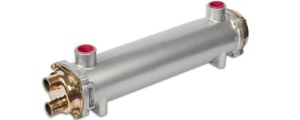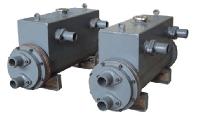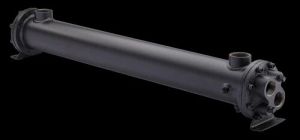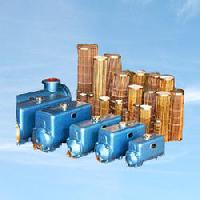
Marine Heat Exchangers
100,000 - 200,000 Per each
1 each (MOQ)
Dear Sir Our Fin Tube Heat Exchangers are fabricated from two metals, copper and aluminium. Stainless steel and aluminium are also available for customized production. The temperature of both can be interchanged using ambient air as cooling medium. These Coils Are Inspected Stringently On Standard Quality Parameters. We Fabricate In Stainless Steel, Copper, Aluminium, Cupronickel , Mild Steel ,Our Wide Range Includes Ahu Cooling Coils, Air Conditioner Coils, Hvac Coils And Steam Heating Coils , Ammonia Refrigeration Coils ,Anti Corrosion Effective Coils. These Are Widely Used In Heating, Ventilating And Air Conditions Systems For Their Effective Functioning. Offered To Clients In Different Specifications To Meet Their Particular Requirements, I'm On Instagram As @fidvirefrigeration. Please Share Your Email I'd. Whatsapp: Http://Wa.Me/+919920941731Http://Www.Chillwatercoolingcoil.In Udyam Number Mh-19-0106460 Udyog Aadhaar Number Mh19b0006544 We Await Your Reply Warm Regards Mustafa Fidvi For Fidvi Refrigeration Industries www.fidvirefrigerationind.in Email: fidvirefind@gmail.com 101, Ajay Industrial Estate, Anjirwadi, Mazgaon, Mumbai 400 010 +919920941731 / +91 22 2372 7112 / 23720967

Marine Plate Heat Exchanger
100,000 - 500,000 Per Unit
1 Unit (MOQ)
Best Deals from Marine Heat Exchanger

Marine Heat Exchanger
20,000 - 50,000 Per Piece
1 Piece (MOQ)

Marine Heat Exchanger
Get Price Quote

Marine Heat Exchanger
Get Price Quote

Marine Heat Exchanger
Get Price Quote
The company is a renowned Exporter and Supplier of Marine Heat Exchanger, which efficiently treats distilled water and antifreeze. The Marine Heat Exchanger transfers the heat from water-antifreeze combine to the incoming water from the water body. The efficiency of the Marine Heat Exchanger, as well as its long service life, ensures that the equipment is worth investing in.

Drum Heat Exchanger
Get Price Quote
1 Piece (MOQ)
We are offering a drum heat exchanger is heat transfer equipment used for transferring heat between two fluids that are at different temperatures. The drum heat exchanger consists of a cylindrical drum that is divided into two sections by a partition wall. The heat is transferred from the hotter fluid to the cooler fluid through the walls of the tubes. Drum heat exchangers are commonly used in the chemical and petrochemical industries for heating or cooling process fluids.

Marine Plate Heat Exchanger
Get Price Quote
Marine Plate Heat Exchanger that we supply is procured from the trusted manufacturers and venders of the market. Our Marine Plate Heat Exchanger is appreciated for its high strength, optimum corrosion resistance and accurate dimensions. We make available Marine Plate Heat Exchanger in different sizes and other technical specifications. Moreover, we gladly welcome the bulk orders for Marine Plate Heat Exchanger.

Marine Heat Exchanger
Get Price Quote
The Marine Heat Exchangers, which we offer, are available in the tubular form, or with an integral header tank, and models are available to suit engines of various outputs. This Marine Heat Exchanger is acclaimed for fast cooling of the marine engine. We are a dependable Manufacturer, Supplier and Exporter of Marine Heat Exchanger. Construction This Marine Heat Exchanger has a bundle of tubes, where two cooling circuits meet and exchange the heat. This bundle of tubes could be in the cooling circuit of an engine (Marine Heat Exchanger), the oil circuit (oil cooler) or intake air (inter cooler). There is a boat that we can supply with a heat exchanger to suit from the smallest petrol or diesel engine to large V8 petrol and medium-range diesels; Vertical Mounting with Integral Header Tank Horizontal mounting with Integral Header. We can manufacture the Tank of Marine Heat Exchanger, using modular construction from standard components. Design : As per ASME Section VIII Div. 1, TEMA RCB, IS 2825 & IS 4503. Capacity : As per Customer Requirements/standard Design Material of Construction : Size ranging from 3� to 100� in diameter & 40� (Feet) in length.

MARINE HEAT EXCHANGER/COOLER & SPARES
Get Price Quote
Leading Wholesale Trader of Alfa Laval Gasketed Plate Heat Exchangers, Alfa Laval MMPX-403 Complete Module, Alfa Laval EPC-400 Control Board, and Alfa Laval EPC/ Viscochief Controller from Bhavnagar.

Marine Heat Exchangers
Get Price Quote
We are leading Manufacturer, Supplier and Exporter of Marine heat exchangers, chennai, India that is manufactured by using high grade raw material as per the client’s requirements. Our range is available in various sizes & specifications and is widely used in different rice mills. These are appreciated in the worldwide market and are offered at the competitive prices.

Marine Heat Exchanger
80,000 Per Piece
1 Piece (MOQ)

Marine Heat Exchanger
Get Price Quote
Marine heat exchangers are the most common way to cool a boat’s engine, using the lake, river or ocean water in which the boat floats. Since this water may be corrosive the engine may be cooled by a sealed mixture of distilled water and antifreeze. Heat from the water-antifreeze mixture is then transferred to the ocean (or lake or river) water which flows into a heat exchanger. The water-antifreeze mixture runs through the heat exchanger dumping heat, but remaining separate from corrosive salts and chemicals found in the water the boat is floating in. If the ocean water eventually corrodes and ruins the heat exchanger it can be replaced at a fraction of the cost of replacing the engine. To protect the marine heat exchanger from corrosive salts, a sacrificial zinc anode is screwed into the heat exchanger. This anode must be periodically replaced as part of regular maintenance. Because the water the boat floats in may be contaminated with floating particles such as wood or styrofoam balls the well designed boat will have a filter (often stainless steel mesh) to remove these particles before they are moved toward the heat exchanger. This filter must be periodically cleaned or else the flow of water to the heat exchanger will become obstructed and the engine will overheat. Marine Uses:- A water-jacketed exhaust manifold is necessary on marine engines to reduce the temperature of the engine-room air space and the exhaust pipe. If the exhaust manifold is in the sea-water circuit it should be installed with the sea-water inlet at the back and the outlet at the front on the top to ensure that it operates completely full of sea-water. If the manifold is in the fresh-water circuit a small by-pass hole must be provided in the thermostat to ensure that some water is circulating through the manifold at ail times. Our development is to combine a water jacketed exhaust manifold with the heat exchanger and header tank. This arrangement is particularly suitable for small series-produced engines; the manifold is cooled by fresh water and as a result a keel-cooled engine can be made by omitting the heat exchanger tube stack and the sea-water pump. On installation the fresh-water outlet from the manifold would be connected to the keel pipes and the return taken back to the engine fresh-water pump. Heat exchanger/manifold assemblies are heavier than ordinary marine manifolds and must therefore be supported on the underside using the fixing lugs provided. When automotive engines are being converted for marine use the existing centrifugal-type pump should be retained for the fresh-water circuit and an additional pump fitted for the sea-water circuit. The sea water pipe bore should be chosen so that the velocity does not exceed 2 m/sec on the suction side and 3 m/sec on the discharge side of the pump. Specifications : Large ships usually carry evaporating plants to produce fresh water, thus reducing their reliance on shore-based supplies. Steam ships must be able to produce high quality distillate in order to maintain boiler-water levels. Diesel engined ships often utilise waste heat as an energy source for producing fresh water. In this system, the engine cooling water is passed through a heat exchanger, where it is cooled by concentrated sea water. Because the cooling water (which is chemically treated fresh water) is at a temperature of 70-80 degrees C, it would not be possible to flash off any water vapour unless the pressure in the heat exhanger vessel was dropped. Partial evaporation is achieved and the vapour passes through a demister before reaching the condenser section. Sea water is pumped through the condenser section to cool the vapour sufficiently to precipitate it. Applications : The distillate gathers in a tray, from where it is pumped to the storage tanks. A Salinometer monitors salt content and diverts the flow of distillate from the storage tanks if the salt content exceeds the alarm limit. Sterilisation is carried out after the evaporator. Evaporators are usually of the shell-and-tube type (known as an Atlas Plant or of the Plate Type such as the type designed by Alfa Laval. Temperature, production and vacuum are controlled by regulating the system valves. Sea water temperature can interfere with production, as can fluctuations in engine load. For this reason, the evaporator is adjusted as seawater temperature changes, and shut down altogether when the ship is manoeuvring. Advantages : An alternative in some vessels, such as naval ships and passenger ships, is the use of the Reverse Osmosis principle for fresh water production instead of evaporators. If the engine is being used to drive auxiliary equipment in a ship and the sea water supply is taken from the ship’s main, ensure that the recommended flow rate cannot be exceeded. To alleviate this problem, a brine-air ejector venturi is used to create a vacuum inside the vessel.

Marine Heat Exchanger
Get Price Quote
Marine heat exchangers are the most common way to cool a boat's engine, using the lake, river or ocean water in which the boat floats. Since this water may be corrosive, the engine may be cooled by a sealed mixture of distilled water and antifreeze. Heat from the water–antifreeze mixture is then transferred to the ocean (or lake or river) water which flows into a heat exchanger. To protect the marine heat exchanger from corrosive salts, a sacrificial zinc anode is screwed into the heat exchanger. This anode must be periodically replaced as part of regular maintenance. Because the water the boat floats in may be contaminated with floating particles such as wood or other detritus most boats will have a filter (often stainless steel mesh) to remove these particles before they flow through the heat exchanger. This filter must be periodically cleaned or else the flow of water to the heat exchanger will become obstructed and the engine will overheat.

Marine Heat Exchanger
Get Price Quote
The water-antifreeze mixture runs through the heat exchanger dumping heat, but remaining separate from corrosive salts and chemicals found in the water the boat is floating in. If the ocean water eventually corrodes and ruins the heat exchanger it can be replaced at a fraction of the cost of replacing the engine. To protect the marine heat exchanger from corrosive salts, a sacrificial zinc anode is screwed into the heat exchanger. This anode must be periodically replaced as part of regular maintenance. Because the water the boat floats in may be contaminated with floating particles such as wood or styrofoam balls the well designed boat will have a filter to remove these particles before they are moved toward the heat exchanger. Because the cooling water (which is chemically treated fresh water) is at a temperature of 70-80 degrees C, it would not be possible to flash off any water vapour unless the pressure in the heat exhanger vessel was dropped. To alleviate this problem, a brine-air ejector venturi is used to create a vacuum inside the vessel. Partial evaporation is achieved and the vapour passes through a demister before reaching the condenser section. Sea water is pumped through the condenser section to cool the vapour sufficiently to precipitate it. The distillate gathers in a tray, from where it is pumped to the storage tanks. Marine heat exchanger is the most common way to cool a boat's engine, using the lake, river / ocean water in which the boat floats. Since this water may be corrosive the engine may be cooled by a sealed mixture of distilled water and antifreeze. Heat from the water-antifreeze mixture is then transferred to the ocean (or lake or river) water which flows into a heat exchanger. A water-jacketed exhaust manifold is necessary on marine engines to reduce the temperature of the engine-room air space and the exhaust pipe. If the exhaust manifold is in the sea-water circuit it should be installed with the sea-water inlet at the back and the outlet at the front on the top to ensure that it operates completely full of sea-water.

Marine Heat Exchanger
Get Price Quote
Hitech Equipments range of heat exchanger are marine heat exchanger, industrial heat exchanger and heat exchanger that Marine Heat Exchangerswe present has been designed and developed in adherence with various international quality Marine Heat Exchangersstandards. These have a compact design and style of construction of the plate arrangement, which allows enhanced performance in Marine Heat Exchangers.

Marine Heat Exchanger
10,000 Per Piece
1 Piece (MOQ)

Marine Coolers Heat Exchanger
Get Price Quote
We are offering marine coolers heat exchanger.the offered marine coolers heat exchanger are the most common way to cool a boat's engine, using the lake, river or ocean water in which the boat floats. Since this water may be corrosive, the engine may be cooled by a sealed mixture of distilled water and antifreeze. Heat from the water�antifreeze mixture is then transferred to the ocean (or lake or river) water which flows into a heat exchanger. To protect the marine heat exchanger from corrosive salts, a sacrificial zinc anode is screwed into the heat exchanger. This anode must be periodically replaced as part of regular maintenance. Because the water the boat floats in may be contaminated with floating particles such as wood or other detritus most boats will have a filter (often stainless steel mesh) to remove these particles before they flow through the heat exchanger. This filter must be periodically cleaned or else the flow of water to the heat exchanger will become obstructed and the engine will overheat. There are three methods employed for water-cooled marine petrol and diesel engines they are: direct cooling: direct cooling of the cylinders and heads by sea-water is unsatisfactory, because the engine - which was probably originally designed for radiator cooling - will run too cold and the sea-water will eventually run the cylinder block and headsheat exchanger cooling: heat exchanger cooling is the most common method, the seawater being isolated in components which can be designed to withstand its corrosive effect. The closed fresh-water circuit can be thermostatically controlled so that the engine operates at its design temperaturekeel cooling: keel cooling is suitable for small boats operating in shallow weedy water, but the need for pipe work external to the hull is a severe limitation

Marine Heat Exchanger
Get Price Quote
Large ships frequently hold evaporating plants to fabricate fresh water, thus tumbling their reliance on shore-based supplies. Steam ships must be able to manufacture high-quality distillate in organize to maintain boiler-water levels. Diesel-engine ships frequently utilize waste heat as an energy foundation for producing fresh water. In this system, the engine-cooling water is passed through a heat exchanger, where it is cooled by concentrated seawater (brine). Because the cooling water (which is chemically treated fresh water) is at a temperature of 70-80 °C (158-176 °F), it would not be possible to flash off any water vapor unless the pressure in the heat exchanger vessel was dropped. To alleviate this problem, a brine-air ejector venturi pump is used to create a vacuum inside the vessel. Partial evaporation is achieved, and the vapor passes through a demister before accomplishment the condenser section. Seawater is pumped through the condenser section to cool the vapor sufficiently to precipitate it.The distillate gathers in a tray, from where it is pumped to the storage tanks. A salinometer monitors salt content and diverts the flow of distillate from the storage tanks if the salt content exceeds the alarm limit. Sterilization is carried out after the evaporator.

Marine Heat Exchanger
Get Price Quote
Marine heat exchangers are the most common way to cool a boat's/ship engine, using the lake, river or Sea water in which the boat floats. Direct cooling of the cylinders and heads by sea-water is unsatisfactory because sea water will eventually ruin the cylinder block and heads. Since this water may be corrosive the engine may be cooled by a sealed mixture of distilled/Fresh water and antifreeze. Heat from the water-antifreeze mixture is then transferred to the Sea (or lake or river) water which flows into a heat exchanger. The water-antifreeze mixture runs through the heat exchanger dumping heat, but remaining separate from corrosive salts and chemicals found in the water the boat is floating in. If the Sea water eventually corrodes and ruins the heat exchanger it can be replaced at a fraction of the cost of replacing the engine.